MIST
Magnetosphere, Ionosphere and Solar-Terrestrial
Nuggets of MIST science, summarising recent papers from the UK MIST community in a bitesize format.
If you would like to submit a nugget, please fill in the following form: https://forms.gle/Pn3mL73kHLn4VEZ66 and we will arrange a slot for you in the schedule. Nuggets should be 100–300 words long and include a figure/animation. Please get in touch!
If you have any issues with the form, please contact This email address is being protected from spambots. You need JavaScript enabled to view it..
Local Time Asymmetries in Jupiter's Magnetodisc Currents
By Chris Lorch (Lancaster University)
Jupiter’s large, rapidly rotating magnetosphere is highly influenced by the presence of a global, centrifugally confined current disk comprised of co-rotating plasma from the volcanic moon Io. Azimuthal and radial currents flow through this current disk closing via magnetic field aligned currents (FACs), which are associated with Jupiter’s main auroral emission. These currents arise from dynamical processes within the magnetosphere, driven by the transport and circulation of Iogenic plasma. Characterising the structure and asymmetries in this current system is key to deciphering the dominant drivers of Jupiter’s magnetosphere-ionosphere (MI) coupled system and the behaviour of its plasma disk.
Previous work by Khurana [2001] examined the solar wind influence on Jupiter’s magnetosphere using equatorial maps of Jupiter’s current disk and the results demonstrated clear azimuthal asymmetries fixed with local time (LT). However, the analysis was limited the lack of spacecraft coverage in the dusk – dayside magnetosphere provided by the Galileo spacecraft.
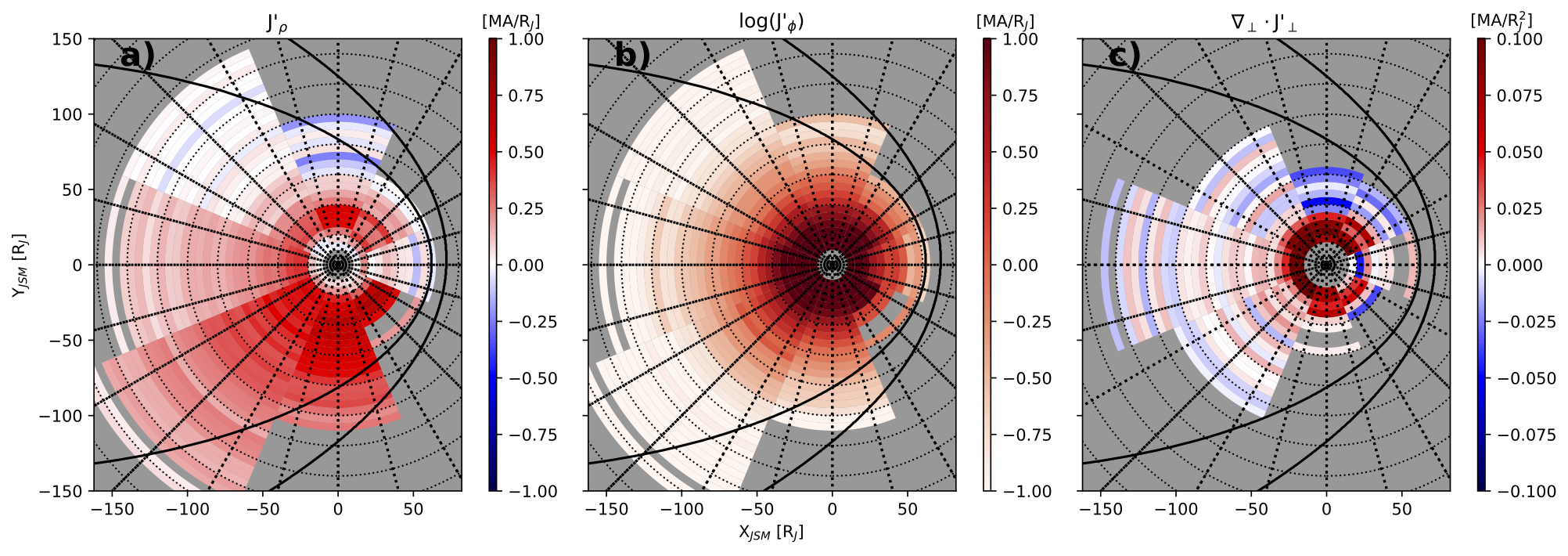
Figure 1: Equatorial maps detailing the structure of Jupiter’s current disk with Jupiter located at (0,0). Dashed circles and radial lines represent 20RJ and 1 hr local time boundaries respectively. A compressed bow shock and magnetopause (Joy et al [2002]) are shown as black solid lines. a) The radial height-integrated current density, warmer (cooler) colours are indicative of current flowing radially outwards (inwards). b) The azimuthal height integrated colour density, flowing in the direction of corotation. c) The divergence of the perpendicular height-integrated current density, indicating the location of upward and downward FACs. Warmer (cooler) colours indicate the presence of upward (downward) FACs.
Lorch et al. [2020] determines the structure of the current disk at all LTs by considering magnetometer data at Jupiter from every available spacecraft, including Juno, up to 28 July 2018. We apply an automated identification tool to magnetometer data from Jupiter’s current disk in conjunction with updated models of Jupiter’s intrinsic magnetic field and current disk geometry. In total, we identify 7382 lobe traversals, calculating the associated height-integrated current density for each crossing. Additional coverage provided by the later half of the Galileo mission and the recent Juno mission allowed us to map all LTs. Asymmetries exist in both the radial (Figure 1a) and azimuthal (Figure 1b) currents into 20 RJ. Furthermore, we quantify the structure of upward and downward FACs in previously unmapped regions of Jupiter’s magnetosphere (Figure 1c). We find a positive net current density of 1.87 MA / RJ2, suggesting unmapped currents must close either down-tail or along the magnetopause. Our results demonstrate important asymmetries in Jupiter’s current systems that play a crucial role in the MI coupled system. Amalgamating these results into future MI coupling models has the potential to remove discrepancies between model predictions and observations.
For more information, please see the paper:
Lorch, C. T. S., Ray, L. C., Arridge, C. S., Khurana, K. K., Martin, C. J., & Bader, A. (2020). Local time asymmetries in Jupiter's magnetodisc currents. Journal of Geophysical Research: Space Physics, 125, e2019JA027455. https://doi.org/10.1029/2019JA027455
Where does slow Alfvénic solar wind come from?
By David Stansby (MSSL, UCL)
The solar wind is a continuous flow of plasma from the surface of the Sun, flowing out into interplanetary space. Faster solar wind is known to originate in large coronal holes, but slower solar wind has a wide range of different sources. A subset of slow solar wind is filled with pure Alfvén waves, much like the fast solar wind, suggesting it has a similar origin in coronal holes.
In our study we tested this theory of coronal hole origin, using Helios in-situ measurements of the solar wind at 0.35 AU. Figure 1 shows a wide range of plasma properties in typical fast solar wind (black), highly Alfvénic slow solar wind (blue), and non-Alfvénic slow wind (red).
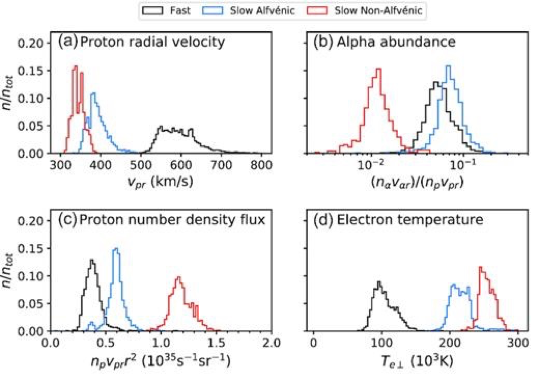
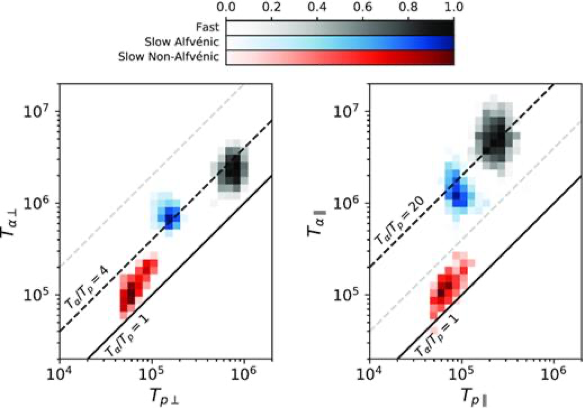
Figure 1: In-situ solar wind properties for three intervals of solar wind, measured at 0.35 AU. The three types of solar wind are Fast (black), Slow Alfvénic (blue), and Slow non-Alfvénic (red).
The fast and Alfvénic slow wind had similar
- Alpha particle abundances
- Alpha particle drift speeds
- Alpha particle temperature anisotropies
- Alpha to proton temperature ratios (in both parallel and perpendicular directions)
These similarities imply that the heating and acceleration mechanisms of fast and slow Alfvénic solar wind are qualitatively similar, acting in the same way on protons and alpha particles. This agrees with the theory that slow Alfvénic wind originates in coronal holes, like fast solar wind.
In contrast, the fast and Alfvénic slow wind had different
- Electron, proton, and alpha particle temperatures
- Mass fluxes
These differences can be explained by different magnetic field geometries in the low corona: slower wind is released on magnetic field lines which undergo more expansion in the corona, increasing the mass flux and reducing the temperatures. This implies that whilst slow Alfvénic wind originates in coronal holes, it most probably originates in small coronal holes.
For more information, please see:
The origin of slow Alfvénic solar wind at solar minimum, Monthly Notices of the Royal Astronomical Society 492, 39–44 (2020), D Stansby, L Matteini, T S Horbury, D Perrone, R D’Amicis, L Berčič, https://doi.org/10.1093/mnras/stz3422
Bifurcated Region 2 Field-Aligned Currents Associated With Substorms
By Harneet Sangha (University of Leicester)
The Earth’s field-aligned currents (FACs) are a key component of the solar wind-magnetosphere-ionosphere-atmosphere coupled system. They connect the magnetosphere to the ionosphere, forming two concentric rings of opposite polarity currents at dawn and dusk. The inner ring (Region 1, R1), at higher latitudes, connects to the magnetopause, whereas the lower latitude ring (Region 2, R2) connects to the inner magnetosphere. By studying them, we are able to observe the energy transfer throughout the system. They are highly variable, and the small scale changes can be difficult to detect. With the use of the Active Magnetosphere and Planetary Electrodynamics Response Experiment (AMPERE) (comprising 66-satellites that gather the data), we can observe these small scale, structures and variations in the FACs on short time scales.
In our work, we have observed a new phenomenon which we describe as the bifurcation of the R2 currents, and the formation of a new R2 current ring (seen in Figure 1). These current signatures appear to be associated with the substorm expansion phase, and during ongoing geomagnetic activity they appear to have a 1 hour quasi-periodicity. We suggest that these bifurcations are related fast, westward flows in the midlatitude ionosphere, known as subauroral polarization streams (SAPS).
We have proposed a new mechanism that describes the formation of these current bifurcations - consecutive particle injections into the inner magnetosphere during disturbed conditions cause separate partial ring currents to form, leading to the presence of distinct R2 current systems.

Figure 1: A series of polar projections of the AMPERE current density data for the Northern Hemisphere on 2 June 2011, from 06:50 to 08:12 UT. The colour scale for downward (blue) and upward (red) FACs saturate at ± 0.5 µA/m2. Concentric circles show colatitudes in steps of 10°, and 12 MLT (local noon) is presented at the top of the plots, with 06 MLT (dawn) on the right. The dashed box shows the dawn-dusk axis. At 06:50 UT a standard R1/R2 FAC distribution is evident. The locations of interest are highlighted in the first panel with arrows, where by 07:44 UT the R2 FACs bifurcate to form two concentric rings and can be seen between 20° and 30° colatitude.
For more information, please see the paper:
Sangha, H., Milan, S. E., Carter, J. A., Fogg, A. R., Anderson, B. J., Korth, H., & Paxton, L. J. (2020). Bifurcated Region 2 field‐aligned currents associated with substorms. Journal of Geophysical Research: Space Physics, 125, e2019JA027041. https://doi.org/10.1029/2019JA027041
Evaluating the Accuracy of Solar Orbiter Plasma Measurements
By Georgios Nicolaou (MSSL, UCL)
The plasma instruments on board Solar Orbiter will determine the three-dimensional velocity distribution functions of the plasma ions and electrons with high time resolution, within heliocentric distances from ~0.3 to 1 au. The analysis of these distributions will determine the plasma bulk parameters (e.g., density, velocity, and temperature). New work by Nicolaou et al. (2019, 2020) assesses the accuracy of these measurements, considering the proton and electron instruments separately.
1. The Impact of Turbulent Solar Wind Fluctuations on Proton Measurements
The Solar Wind Analyser’s Proton Alpha Sensor (SWA-PAS) on board Solar Orbiter will measure solar wind plasma protons. However, due to the dynamic and turbulent nature of solar wind plasma, the accurate determination of the plasma parameters from the observations is significantly challenging. Nicolaou et al. 2019, simulated turbulent solar wind proton plasma that exhibits the typical features of turbulence spectrum. They modelled the expected observations by SWA-PAS (see Figure 1) and analyzed them using standard analysis methods in order to quantify the accuracy of the derived plasma bulk parameters. The results show that the typical turbulence will not significantly affect the accuracy of the high-time resolution measurements by SWA-PAS. In addition, the authors compare the accuracy of the instrument as a function of the acquisition time and discuss the sources of errors in the derived parameters.
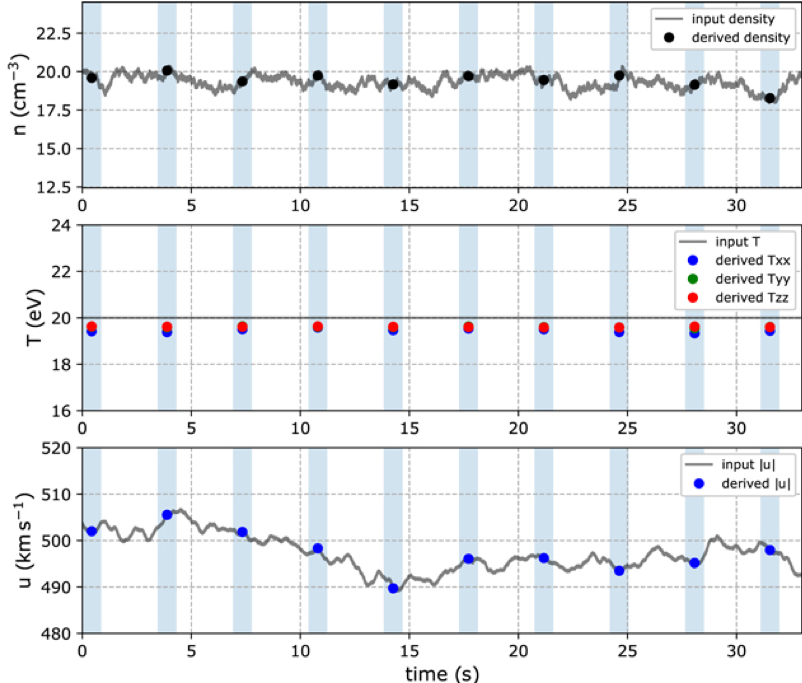
Figure 1. Time series of modeled solar wind with a turbulent spectrum consisting of Alfvén waves and slow modes and a comparison to derived moment parameters from the expected SWA-PAS observations at lower resolution. Each panel shows the input data (gray line) and the moments derived from the modeled observations (bullets). The shadowed areas represent the time intervals in which the instrument collects counts to construct an entire 3D VDF. The top panel shows the plasma density the middle panel shows the diagonal elements of the plasma temperature tensor, and the bottom panel shows the plasma bulk speed. Besides the small systematic underestimation of the plasma density and plasma temperature, the derived moments suggest that the accuracy of SWA-PAS measurements, under typical turbulent solar wind conditions, is remarkably high.
2. Determining the Bulk Parameters of Plasma Electrons from Pitch-Angle Distribution Measurements
The Solar Wind Analyser’s Electron Analyser System (SWA-EAS) is designed to observe the solar wind electrons. In burst-mode operations, the instrument will obtain measurements in the 2D velocity space (as opposed to full 3D velocity distributions) in order to construct the pitch angle distributions of plasma electrons. The reduction of one dimension reduces the statistical significance of the observations and makes the analysis more challenging. Nicolaou et al. 2020, investigate the expected accuracy of the derived bulk parameters of supra-thermal electrons, which are often described by kappa distribution functions. They simulate the expected observations within the heliocentric distance range from 0.3 to 1 au and derive the plasma bulk parameters by fitting the synthetic observations (see Figure 2). The study shows that the proper fitting analysis of the measurements can derive the plasma parameters with significant accuracy, even at 1 au, where the expected particle flux is very low.
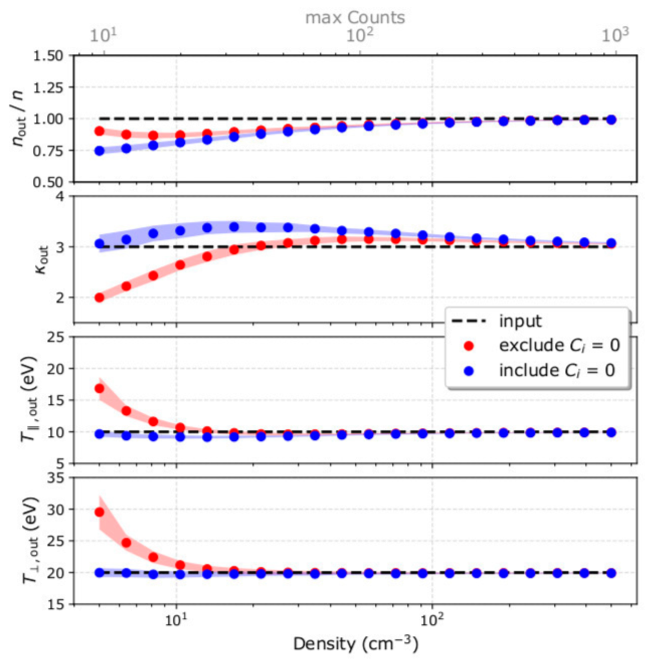
Figure 2. (From top to bottom) The derived electron density over input density, kappa index, parallel and perpendicular temperature as functions of the input plasma density. The red points represent the mean values (over 200 samples) of the parameters derived by fitting only the measurements with Ci ≥ 1. The blue points represent the mean values of the parameters derived by fitting to all measurements including those with Ci = 0. The shadowed regions represent the standard deviations of the derived parameters. The dashed lines represent the input parameters.
For more information, please see the papers:
Nicolaou, G., Verscharen, D., Wicks, R. T., & Owen, C. J. (2019). The Impact of Turbulent Solar Wind Fluctuations on Solar Orbiter Plasma Proton Measurements. The Astrophysical Journal, 886:101. https://doi.org/10.3847/1538-4357/ab48e3
Nicolaou, G., Wicks, R., Livadiotis, G., Verscharen, D., Owen, C., & Kataria, D. (2020). Determining the Bulk Parameters of Plasma Electrons from Pitch-Angle Distribution Measurements. Entropy, 22, 103. https://doi.org/10.3390/e22010103
Modelling the temporal variability in Saturn's magnetotail current sheet from the Cassini F‐ring orbits
By Omakshi Agiwal (Imperial College London)
The Cassini spacecraft completed 20 high latitude orbits known as the ‘F-ring orbits’ during the end of mission (corresponding to northern Saturnian summer). Each orbit provided a ~2 day sample of the magnetotail region, where the measured radial magnetic field Br and the position of the magnetic equator/magnetotail current sheet centre (indicated by Br=0) showed significant orbit-to-orbit variability, despite a highly repeatable spacecraft trajectory.
Our work considers two well-known sources of temporal variability in the Saturnian magnetosphere:
- Solar wind forcing, which acts to displace the magnetic equator from the rotational equator. The forcing increases with radial distance from the planet and is variable with solar wind conditions on ~ week-long timescales.
- Planetary period oscillations (PPO), which refer to two magnetic perturbation systems (one in each hemisphere) that rotate independently around Saturn’s spin/dipole axis with periods of ~10.7 hours. They modulate the vertical position and thickness of the magnetotail current sheet depending on their relative strength and phase.
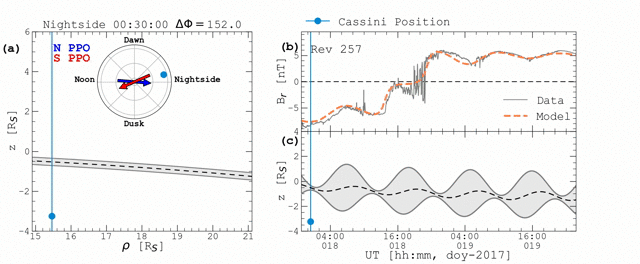 Figure 1: (a) Illustrates the spacecraft (blue dot) traversing our temporally variable modelled current sheet, shown by the shaded grey region. The position of the magnetic equator is shown by the dashed black line. The two arrows on the polar-plot show an equatorial projection of the northern (blue) and southern (red) PPO fields rotating with a ~ fixed relative phase (ΔΦ), with the spacecraft on the nightside. (b) Shows the time-series of Br measured by the magnetometer (solid grey line) and the modelled (dashed orange line) from our work. (c) Illustrates the temporal evolution of the z-position of the magnetic equator and the thickness of the current sheet from the model.
Figure 1: (a) Illustrates the spacecraft (blue dot) traversing our temporally variable modelled current sheet, shown by the shaded grey region. The position of the magnetic equator is shown by the dashed black line. The two arrows on the polar-plot show an equatorial projection of the northern (blue) and southern (red) PPO fields rotating with a ~ fixed relative phase (ΔΦ), with the spacecraft on the nightside. (b) Shows the time-series of Br measured by the magnetometer (solid grey line) and the modelled (dashed orange line) from our work. (c) Illustrates the temporal evolution of the z-position of the magnetic equator and the thickness of the current sheet from the model.
We combine models that consider the effects of each perturbation source on Br, and the model output for the magnetotail pass of an example orbit is shown in Figure 1. Overall, we show that the temporal variability in 90% of the F-ring orbits is consistent with the expected variability due to solar wind forcing and dual-PPO modulation. This demonstrates an understanding of the key sources of large scale variability in Saturn’s magnetotail, and shows that magnetotail dynamics can reliably be studied using high latitude orbits (which is novel in our method).
For more information, please see the paper:
Agiwal, O., Hunt, G. J., Dougherty, M. K., Cowley, S. W. H., & Provan, G. ( 2019). Modelling the temporal variability in Saturn's magnetotail current sheet from the Cassini F‐ring orbits. Journal of Geophysical Research: Space Physics, 124. https://doi.org/10.1029/2019JA027371